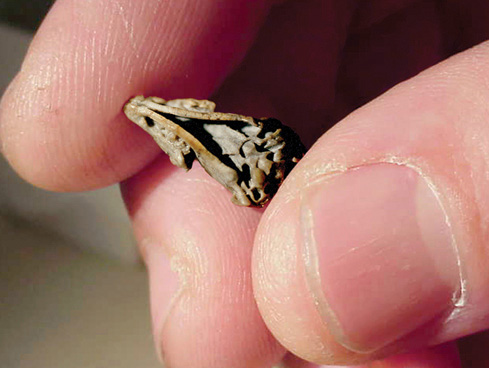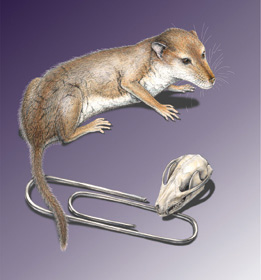 Fall 2011
Fall 2011|
“The discovery of this particular skull worked hand-in-hand with the developments in CT scanning to provide us with a look at a very early step in the evolution of the brain in modern mammals.” - R. Glenn Northcutt, Professor of Neurobiology, University of California at San Diego
|
Big on Brains
Mammal expert Zhe-Xi Luo and colleagues use new technology to sniff out the fact that large brains in mammals first developed not for thinking but for a better sense of smell.
Reconstruction of the skullIn the flat of his hand, Zhe-Xi Luo holds a replica skull of a tiny creature that’s among one of the biggest discoveries in the study of early mammal evolution. Seven times larger than the real deal, the arrowhead-shaped bronze cast barely covers Luo’s palm. And while a completely intact 190-million-year-old skull that’s smaller than a fingernail and weighs barely as much as a paper clip is a rare find, understanding what is inside that fossilized skull is rarer still. “This little mammal had a very big brain for its size,” says Luo, world-renowned mammal expert and curator of vertebrate paleontology at Carnegie Museum of Natural History. “We knew that because all mammals have brains that are proportionately bigger compared to their body size. But we didn’t know what the brain looked like in the fossil skull, let alone its likely functions.” Chances to study fossil mammal brains are uncommon for scientists. Once in a while, the fossilized brain cast in a skull is naturally exposed so that the shape and size of its brain can be determined. When there are duplicate fossils, a skull can be cut, sliver by sliver, to expose the brain inside. But for the invaluable Hadrocodium, no scientist could afford to slice and dice this once-in-every-200-million-years find—until a 21st-century breakthrough came along that could reveal its long-hidden secrets without damaging the fossil. The rare skull was first discovered during fieldwork in 1986 in Yunnan, China, by a colleague of Luo’s who kicked what he thought was a pebble on the ground. But it was no ordinary pebble, rather the skull of the oldest known close relative of living mammals. Because of its importance, every external detail on the fossil skull was studied, but little was known of its interior, until a 2003 trip to the Lone Star state, where scientists at the University of Texas at Austin used high-resolution CT scans to peer inside the fossil harmlessly.
To a degree, the results confirmed what Luo and others ascertained through nearly 15 years of old-fashioned observation. “There wasn’t a ‘Eureka’ moment during the many years of its study,” says Luo. “We didn’t even realize that it was a mammal until two to three years after it was first discovered. Then, it took another four to five years before we understood that this was a new animal. It was a gradual, systematic process.” Immediately obvious from the CT scanning, the specimen showed a large olfactory passage; or, in less scientific terms, a really big nose. What the 3-D image analysis further revealed is that the skull has more space for a growing brain, enlarged to accommodate the animal’s enhanced sense of smell, in addition to a well-developed sense of hearing, all of which aided Hadrocodium’s hunting abilities and chances of survival. Living in the shadow of dinosaurs and other large animals that dominated the Jurassic landscape, the less-than-pint-sized creature used its elongated nose and extra brain capacity to search out a diet of small worms and insects at night to avoid being crushed or eaten by its bigger predators, says Luo. That bigger brain also improved the mammal’s tactile senses from the fur that covered its body. Though much of any brain’s workings, such as memory and behavior, are still a riddle, some of its functions are readily understood. “In some ways, the way the brain operates is quite simple and easy to figure out,” says Rowe. “If you see a lot of neural real estate in the olfactory bulb, then that means the animal has a pretty good sense of smell. And that’s what we were able see in this skull through the scans, without destroying it.” The story of the skull, the high-resolution CT scans, and the study results appeared in the May 2011 issue of Science, and are extremely significant, says R. Glenn Northcutt, who wrote the perspective of the article by the University of Texas and Carnegie Museum scientists. “Until recently, not much fossil record of this type was available,” says Northcutt, a professor of neurobiology at the University of California at San Diego. “First, because most animals don’t fossilize, when they do it’s rare to find whole skulls. The discovery of this particular skull worked hand-in-hand with the developments in CT scanning to provide us with a look at a very early step in the evolution of the brain in modern mammals.” For Carnegie Museum of Natural History, the discovery takes on a different type of importance. “At a museum with its core value in research, we are interested in finding out the most fundamental aspects of science,” says Luo. “We have a small cluster of experts in vertebrate paleontology and early mammal evolution, and we work with experts from around the world. Collaboration is one of our strengths, and the reason we have been at the forefront in making so many major discoveries over the years.” Perhaps it takes a big brain to know one?
|
In Praise of the Superhero · For the Birds … and the Environment · Picturing Pittsburgh · The STEM solution · Directors' Note · NewsWorthy · Face Time: Kristoffer Smith · Artistic License: Architectural Wonder · First Person: Summer Dreaming · The Big Picture
 |
Copyright © 2017 CARNEGIE Magazine. All rights reserved. |


